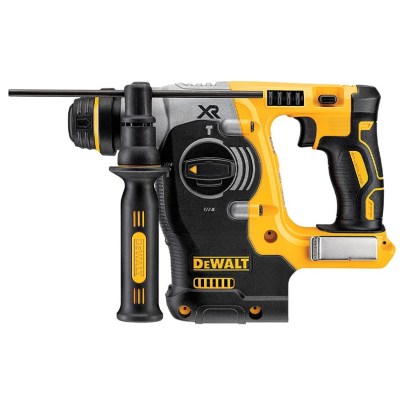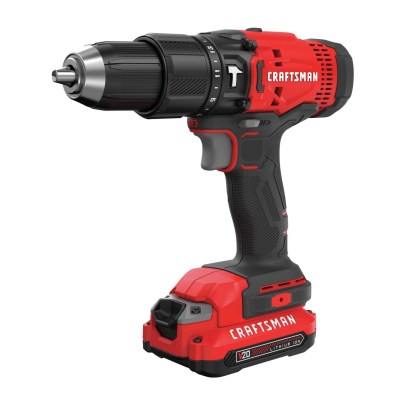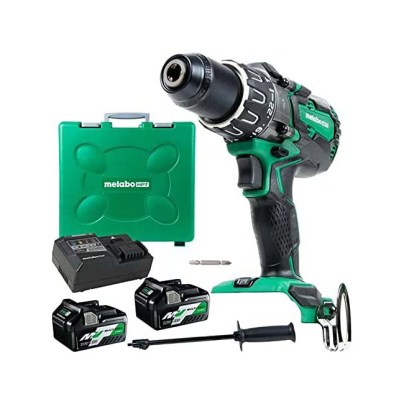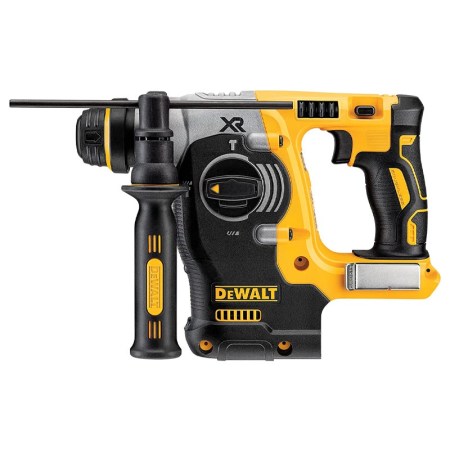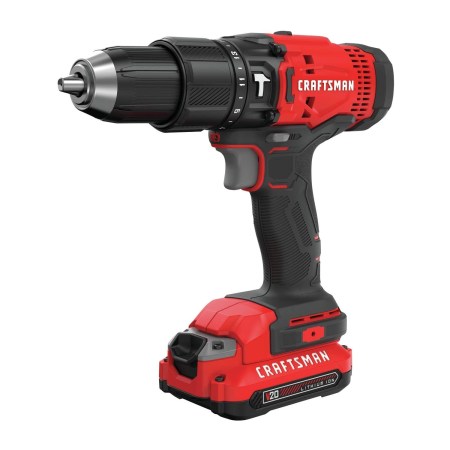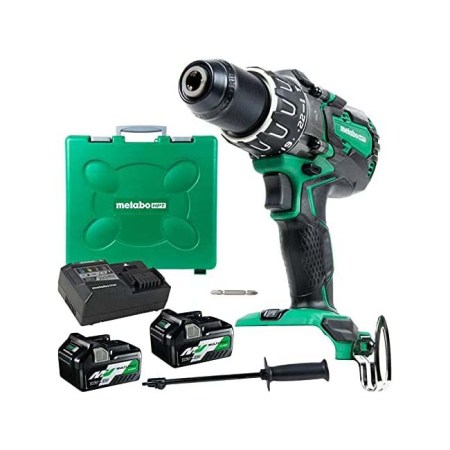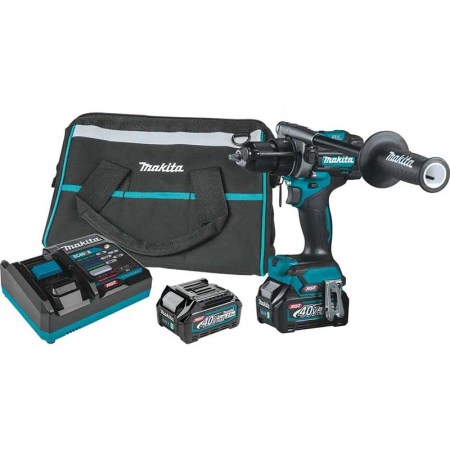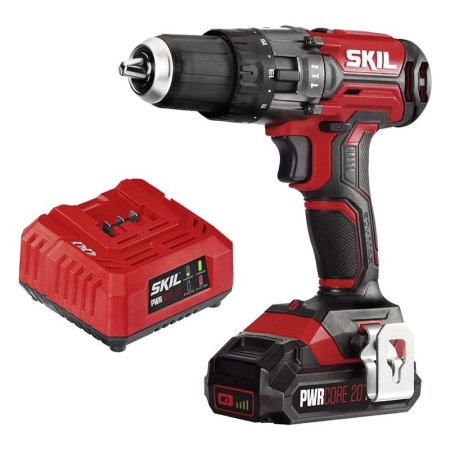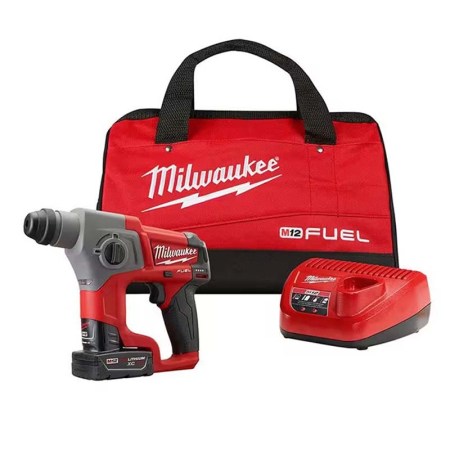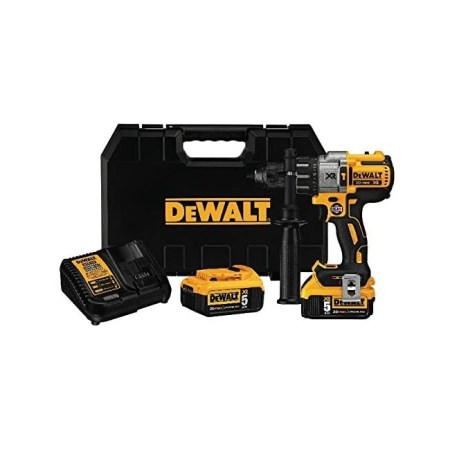We may earn revenue from the products available on this page and participate in affiliate programs. Learn More ›
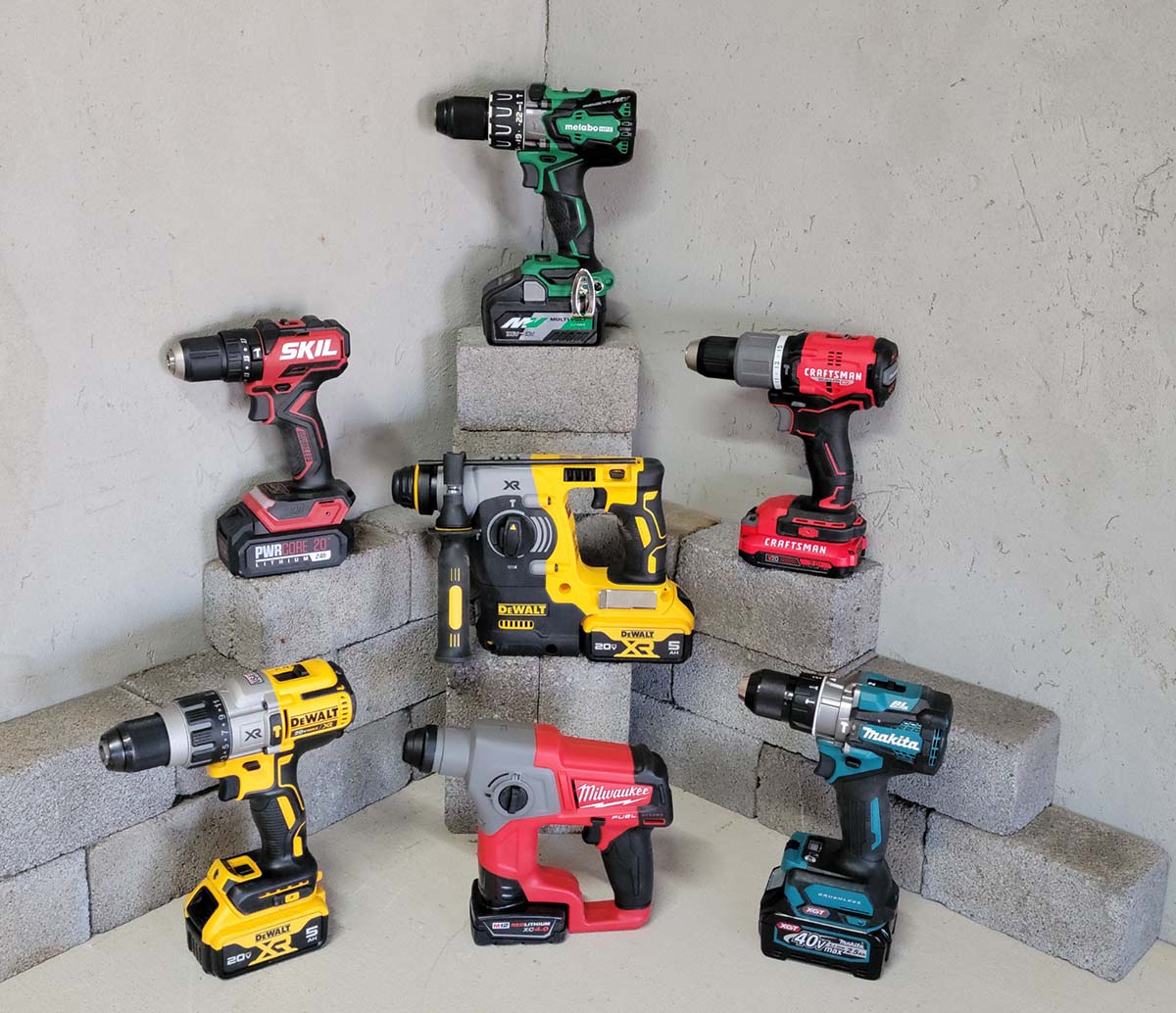
Drilling through concrete, bricks, and stone requires additional force from a drill, and even the most powerful corded drill drivers can’t stand up to the task. These intense drilling projects require the extra oomph of a hammer drill. This power tool does two things: It spins the bit while simultaneously generating a rapid hammering action. The double action of a hammer drill boosts its drilling power—making it possible to drill through tough masonry materials.
Several national manufacturers produce cordless hammer drills, and we wanted to find out which ones were best suited to drilling through various types of masonry, so we tested them. We selected the highest-rated models and then drilled holes in concrete, ceramic tile, and cinder brick. Then we documented each tool’s ability, performance, and design aspects—pros and cons.
The following list represents the models that scored highest in our hands-on testing. They range in weight, power, and price, but each one earned its spot on this lineup of the best cordless hammer drills.
- BEST OVERALL: DeWalt 20V MAX 1-Inch XR SDS Plus Rotary Hammer
- BEST BANG FOR THE BUCK: Craftsman V20 Cordless ½-Inch Hammer Drill Kit
- BEST FOR HEAVY-DUTY: Metabo HPT 36V MultiVolt ½-Inch Hammer Drill
- BEST FOR MEDIUM-DUTY: Makita 40V Max XGT Brushless ½-Inch Driver-Drill Kit
- BEST FOR LIGHT-DUTY: Skil PWRCORE 20 20V ½-Inch Hammer Drill Kit
- BEST COMPACT: Milwaukee M12 Fuel ⅝-Inch SDS Plus Rotary Hammer Kit
- ALSO CONSIDER: DeWalt 20V MAX XR Cordless Hammer Drill/Driver Kit
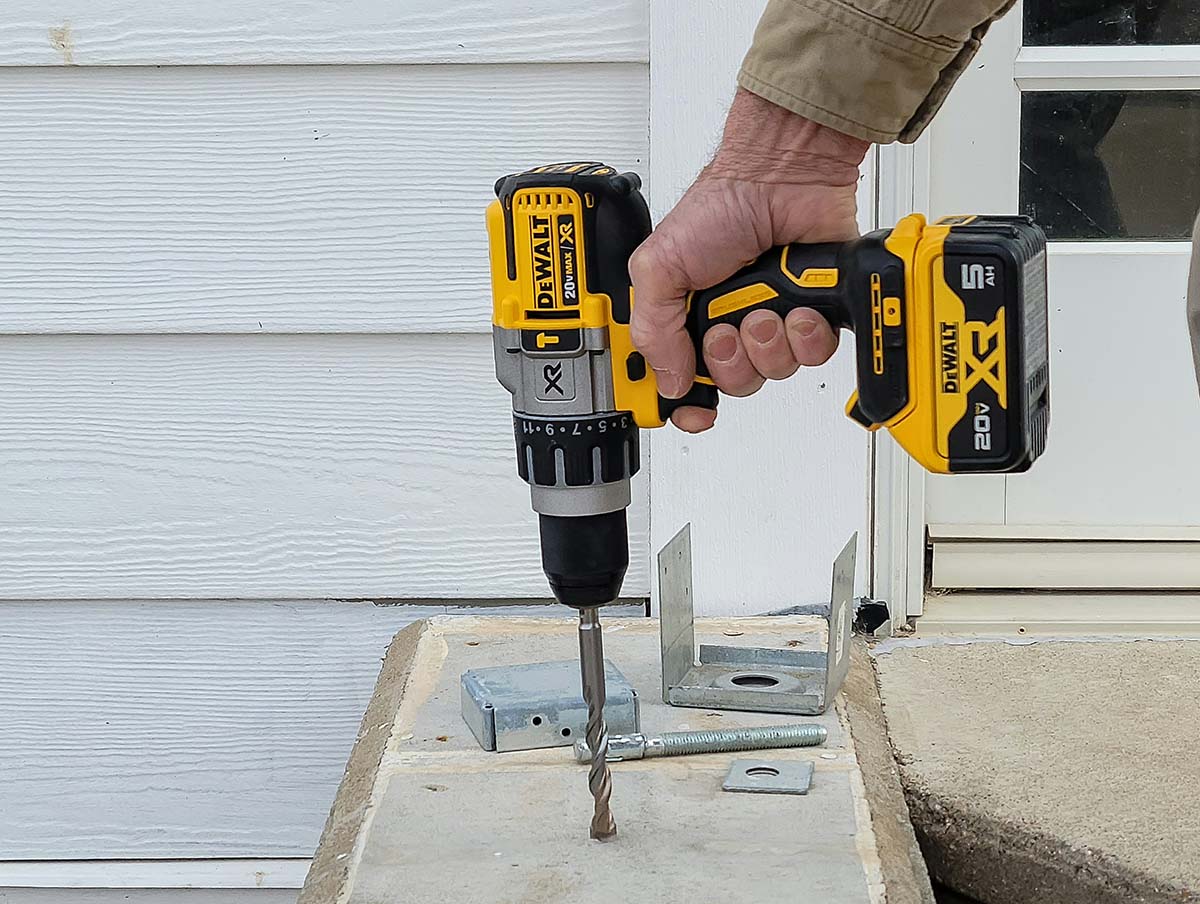
Before You Buy a Cordless Hammer Drill
In general, hammer drills (corded and cordless) are considered masonry-only drills, so don’t mistake them for typical cordless drills, although many come with a drill-driver option. Even compact hammer drills often have heavy-duty components, which means they are substantially heavier than standard cordless drills. They also have much more torque, so don’t be surprised by their power.
You probably don’t need a cordless hammer drill if you’re not drilling into concrete, bricks, stone, or other masonry. Instead, just save a bit of money and use a standard drill for most other projects. However, for those frequently mixing concrete or paint, the extra torque hammer drills offer can help speed up the task.
How We Tested the Best Cordless Hammer Drills
In selecting the models for our hands-on tests, we researched the most sought-after cordless hammer drills in their respective categories. We considered power output, speed, motor type, battery type, weight, and unique features.
We also considered brand to a large extent. Manufacturers such as DeWalt, Makita, and Milwaukee have excellent reputations for producing high-end power tools for both pros and DIYers. Still, we didn’t automatically eliminate other brands if their models rated highly with users.
In actual testing, we fitted each hammer drill with various-size masonry bits and used them to drill through concrete, ceramic tile, and cinder bricks. As we tested, we awarded points based on a rubric. The better a hammer drill performed a specific function, the more points it received. We also awarded points for material quality, ergonomics, and any special features the drills came with.
After testing, we added and averaged the points and used them to help determine the best categories for each tool.
Our Top Picks
The following list of cordless hammer drills excelled in our hands-on tests for drilling through masonry materials. While they vary in power, price, and best use, each model stands out in its category. Discover how each of these popular hammer drills performed in our tests, and find out what we liked best (and disliked) about each one before buying the best hammer drill for your needs.
Best Overall
DeWalt 20V MAX 1-Inch XR SDS Plus Rotary Hammer
See ItThe DeWalt drill powered through all our masonry-drilling tests without a glitch. We’re familiar with many DeWalt power tools, but this was our first use of its rotary hammer drill, and we weren’t disappointed.
Traditionally, rotary hammers are large and unwieldy, making them a burden in the tool box, but this isn’t the case with the DeWalt rotary hammer. This heavy-duty tool has a standard pistol-style grip, which makes it easy to grasp and control. It came without a battery, so we paired it with a DeWalt 5.0-amp-hour (Ah) rechargeable battery for testing. This tool has so much power and torque that we wouldn’t suggest using it with anything less than a 3.0Ah battery. The higher the capacity battery, the better.
We started with a large masonry bit and tested the DeWalt hammer drill’s ability to drill through concrete. It drilled through smoothly, and the ergonomic design allowed us to get a firm grip to maintain steady pressure. It drilled holes just as easily through cinder bricks. This model comes with a special chipping feature, so we inserted a masonry chip bit (shaped like a paddle) and used the rotary hammer to chip old grout off used bricks; it worked well and was simple to control.
This specific model is a little beefy for drilling through ceramic tile, but we tested it for that purpose by switching to a smaller bit. It drilled a smooth hole through the tile without cracking or chipping the surface glaze. Still, we prefer a lighter model to drill through tile, which requires a delicate touch. The DeWalt weighs just under 8 pounds with the 5Ah battery, making it an ideal weight for heavy-duty drilling.
DeWalt’s brushless motor generates up to 4,600 beats per minute (bpm) and a top speed of 1,050 rotations per minute (rpm). While this is lower than some of the other models we tested, the DeWalt isn’t built for speed but for long-term power. Drilling through concrete isn’t a speedy chore. The tool has a dial for selecting drill only, chipping, or drill and hammer combined. A nice feature is the depth rod on the top of the tool that can be adjusted to suit the desired drill depth.
The DeWalt has a brushless motor for enhanced power and durability, a side accessory handle, a belt hook, and a slotted drive shaft/system (SDS) chuck. An SDS chuck is designed for use with SDS bits, which lock into place via twisting rather than tightening the chuck as is typical with nonSDS (3-jaw) chucks.
Read our full review: DeWalt 20V MAX 1-Inch XR SDS Plus Rotary Hammer
Product Specs
- Model: DCH273B (tool only)
- Maximum speed: 1,050 rpm/4,600 bpm
- Battery type: Lithium-ion
Pros
- Ergonomic design and grip make it easy to grasp and control the tool
- 3 modes: drill only, hammer only (chipping), or a combination of hammer and drill
- Adjustable depth-stop rod makes it easy to know when users have drilled the required depth
Cons
- Slightly heavy for repeated drilling through ceramic tile, which requires a delicate touch
Get the DeWalt SDS cordless hammer drill at Amazon, Ace Hardware, or Acme Tools.
Best Bang for the Buck
Craftsman V20 Cordless ½-Inch Hammer Drill Kit
See ItDon’t spend a lot on a hammer drill for around-the-house DIY projects such as drilling through tile or occasionally drilling through concrete. We found the Craftsman V20 hammer drill both efficient and affordable.
First, this is not a heavy-duty hammer drill like the one that took the top spot in our lineup, but it’s powerful enough for many DIY uses. We charged both of the 2.0Ah batteries that came with the drill (although some retailers sell this drill with 1.3Ah batteries) and started testing by drilling through the ceramic tile with a masonry bit. We could make clean holes without chipping or cracking on both the high and low speeds. We were able to switch between drill-only and hammer drill modes.
We then switched to drilling holes in concrete and cinder brick. The Craftsman hammer drill tended to bog down slightly if we used too much pushing pressure when drilling through concrete. That could be related to both its brushed motor—brushed motors aren’t quite as powerful as brushless motors—or it could be associated with its low-capacity batteries. Craftsman tool users with higher-capacity batteries may want to use them in this drill.
This hammer drill produces up to 1,500 rpm at high speed, sufficient for most light- or medium-duty projects. When it comes to boring holes in brick or concrete, the Craftsman produces up to 25,500 bpm—more than respectable from a value-priced model. We wouldn’t suggest it for someone who needs to drill mainly in dense concrete, but it’s a good pick for drilling through ceramic tile, cinder bricks, or the occasional hole in a concrete basement floor.
Product Specs
- Model: CMCD711C2
- Maximum speed: 1,500 rpm/25,500 bpm
- Battery type: Lithium-ion
Pros
- 2 speed options and the ability to switch between drill and hammer drill modes
- Suitable for light- to medium-duty projects
- Features an onboard LED guide light—helpful for use in low-light situations
Cons
- The included batteries are relatively low capacity and require frequent recharging
Get the Craftsman cordless hammer drill at Amazon or Ace Hardware.
Best for Heavy-Duty
Metabo HPT 36V MultiVolt ½-Inch Hammer Drill
See ItMetabo HPT (not to be confused with tools from the German manufacturer Metabo) has created a powerful hammer drill well suited to outdoor or shop use. After charging the two included 2.5Ah batteries, we started testing by drilling holes in concrete using a masonry bit.
We successfully drilled into the concrete while using moderate pushing force without the drill bogging down. It began to drag a bit if we exerted a lot of pressure. It drilled smooth holes in cinder brick and even cleaner ones in ceramic tile; we partly attributed this to its variable-speed trigger that let us start drilling at a very slow speed, which helped keep the tile from chipping.
The Metabo HTP hammer drill offers two speeds; users can choose between standard drilling and hammer drilling.
Although this is a reasonably lightweight hammer drill at just 4.5 pounds (minus the battery), it offers quite a bit of torque and power—2,100 rpm and up to 31,500 bpm. In addition, we found the Metabo HPT vibrated less on hammer-drill mode than some of the other standard models we tested, making it easier to use for prolonged periods.
The thing that sets this hammer drill apart is its optional AC adapter (sold separately) that allows users to plug it into an electrical outlet, making it well suited for shop use. Remember that using a drill inside a shop can lead to excessive dust and mess. The Metabo HPT comes with a bright LED guide light that makes it handy for low-light situations and features a belt hook. This is a decent all-around hammer drill that offers an added benefit with the AC plug-in option.
Product Specs
- Model: DV36DAG
- Maximum speed: 2,100 rpm/31,500 bpm
- Battery type: Lithium-ion
Pros
- Brushless motor increases the hammer drill’s power and efficiency
- Lightweight and well designed, this tool can be used longer without muscle fatigue
- Optional AC adapter allows users to operate the device via an electrical outlet
Cons
- Slight motor drag if significant pushing force is used when drilling concrete
Get the Metabo HPT cordless hammer drill at Amazon, Acme Tools, or Lowe’s.
Best for Medium-Duty
Makita 40V Max XGT Brushless ½-Inch Driver-Drill Kit
See ItMakita has a reputation for producing top-notch tools, so we were excited to test its new hammer drill, yet we were slightly skeptical about its digital clutch. All the drills we’ve used in the past came with clutch rings for manually adjusting the torque needed to insert screws without stripping out the heads. How would a digital clutch fare?
Still, our main testing concern was how well the Makita would bore holes in concrete and other masonry materials, and in that area, it performed very well. Its brushless motor delivered ample torque and power, and the percussion hammering was reasonably smooth—it didn’t reverberate through our hands and arms as some hammer drills do. It excelled in drilling holes in concrete, cinder brick, and ceramic tile.
The Makita offers three modes: hammer drill, standard drill, and driver (for screws). We switched to driver mode to turn on the digital clutch, and a small LED readout on the tool’s base lit up. We could select from a range of clutch settings via a button.
We tested the digital clutch’s torque and slip (degree of resistance necessary to stop the bit from turning) by inserting screws into pine lumber. We felt the digital clutch was as accurate as any manual clutches we’ve worked with, but there’s an additional digital lock that we had to depress and hold for a couple of seconds each time before we could select the clutch range. For professionals who want to speed up their projects, repeatedly needing to unlock the digital clutch may become annoying.
On the other hand, those who purchase the Makita primarily for hammer-drill purposes may not mind occasionally navigating the lock feature. This powerful tool comes with two speed modes, a variable-speed trigger, bright LED light, a removable bar handle for two-hand stability, two 2.5Ah batteries, and a charger.
Product Specs
- Model: GPH01D
- Maximum speed: 2,600 rpm/39,000 bpm
- Battery type: Lithium-ion
Pros
- Low vibration in hammer mode for reduced hand and arm fatigue
- Offers 3 modes: hammer drill, standard drill, and driver mode
- Powerful brushless motor provides ample torque for drilling through concrete
Cons
- The need to press and unlock the digital clutch may slow down some users
Get the Makita cordless hammer drill at Amazon, The Home Depot, or Acme Tools.
Best for Light-Duty
Skil PWRCORE 20 20V ½-Inch Hammer Drill Kit
See ItWhen it comes to minor home repairs or DIY projects, a light-duty, reliable option is the Skil 20V ½-inch hammer drill. This three-in-one tool functions as a hammer drill, drill, and screwdriver and comes with two speed settings: high and low.
We tested the Skil hammer drill after fully charging its included 2.0Ah battery. That’s on the low-capacity side, but it should still provide ample power for drilling an occasional hole in a concrete patio or basement floor. We found the motor on the Skil bogged down a bit when we increased the pushing force while drilling in concrete, but when we eased up, it drilled fine. This hammer drill doesn’t have a brushless motor, but it’s still suitable for light-duty use. We wouldn’t use it to drill more than a dozen holes in succession, and we wouldn’t exert too much pressure.
The Skil was also successful at drilling through cinder brick and ceramic tile. In fact, we found it drilled some very smooth holes in the tile without chipping the surface glaze. In hammer mode, it vibrated more than other models we tested but not too much to handle. It features two additional modes, drill and driver, and it comes with a belt clip to boot. We wouldn’t hesitate to keep it on hand for those times when we need to drill a couple of masonry holes, but we wouldn’t consider it a jobsite prospect.
Product Specs
- Model: HD527802
- Maximum speed: 1,450 rpm/ 21,750 bpm
- Battery type: Lithium-ion
Pros
- Suitable for drilling in wood and metal in addition to masonry materials
- 2 speed settings and 3 modes: hammer drill, drill, driver
- LED light offers added illumination in low-light work situations
Cons
- This model is not as powerful as the others we tested, so its use is limited
Get the Skil cordless hammer drill at Amazon or Lowe’s.
Best Compact
Milwaukee M12 Fuel ⅝-Inch SDS Plus Rotary Hammer Kit
See ItWe’re big fans of Milwaukee tools, but we were perplexed as to why the company would make a rotary hammer drill in a 12-volt version. Hammer drills are typically considered more powerful than standard drills, and rotary hammer drills (like the best overall pick in this lineup) are among the most powerful of all. While other manufacturers are producing 20- and 36-volt hammer drills, why would Milwaukee incorporate rotary technology in a lower-capacity 12-volt model? What we discovered sold us on this little powerhouse.
Since it’s a rotary hammer drill, the compact Milwaukee takes SDS bits, so we loaded an SDS masonry bit and started testing by drilling into concrete. Surprisingly, this little 12-volt drill was pretty powerful, and we could quickly drill holes in concrete, cinder brick, and tile. The hammering action was smooth. It felt more like a gentle vibration than percussion, so it was comfortable to use. Some may consider it a one-handed hammer drill, but we felt it would benefit from an accessory bar for added stability.
This compact model has only two modes—drill and hammer drill. Unlike many rotary hammers, it doesn’t feature a chipping mode.
The Milwaukee 12-volt isn’t going to replace a full-size rotary hammer drill anytime soon. It’s not designed to compete with full-size 18- and 20-volt models. The lower voltage motor is better suited to light-duty use rather than commercial or heavy DIY use. Still, it’s an excellent pick for a pro, such as an electrician or plumber, who has to drill occasional holes in a masonry wall to run wiring or conduit. It’s perfect for use in tight spots. Like other Milwaukee tools, this little hammer drill is high performance despite being small. We were impressed with its power and design.
Product Specs
- Model: 2416-21XC
- Maximum speed: 900 rpm/ 6,200 bpm
- Battery type: Lithium-ion
Pros
- Compact and lightweight, making it well suited for use in restricted spots
- LED light is bright and illuminates the work area in low light
- Brushless hammer drill motor provides plenty of power and torque in a small hammer drill
Cons
- Doesn’t come with an accessory bar for 2-handed use
Get the Milwaukee cordless hammer drill at Amazon, The Home Depot, or Acme Tools.
Also Consider
DeWalt 20V MAX XR Cordless Hammer Drill/Driver Kit
See ItThe DeWalt 20V MAX XR hammer drill kit is an excellent choice for an all-around hammer drill. Our second DeWalt to make this lineup of the best cordless hammer drills is a conventional model rather than a rotary model, and like most DeWalt power tools, it’s a top-notch pick for power and performance.
We were impressed as we unboxed it and discovered it came with two 5.0Ah batteries. Rechargeable lithium-ion batteries can be pricey—sometimes costing as much as the power tool itself if purchased separately—so it was a treat to find two high-capacity batteries with the DeWalt.
In testing, the DeWalt hammer drill continued to impress. We could drill quickly through concrete and cinder brick. However, we did experience some surface chipping when drilling through ceramic tile, but that’s not unusual when working with powerful hammer drills. In addition, we were starting to experience some hand and arm fatigue after testing several models and may not have been as steady holding the drill as we normally would have been. The tool does come with a variable-speed trigger, which makes it easier to start drilling slowly without shattering a glazed tile surface.
The DeWalt features a brushless motor for enhanced power and three modes: drill, hammer drill, and driver. We really liked the LED light, which can be dimmed to conserve battery power or cranked up on high for spotlight-bright illumination. That’s a handy addition we’d like to see on more power tools. Overall, this is a dependable and powerful hammer drill well suited to DIY and professional use.
Product Specs
- Model: DCD996P2
- Maximum speed: 2,250 rpm/38,250 bpm
- Battery type: Lithium-ion
Pros
- LED light allows users to dim the light to conserve battery power or use it in spotlight mode
- Comes with 2 high-capacity 5.0Ah batteries and a charger
- DeWalt includes a hard case for storing and protecting the tool
Cons
- Batteries fit tightly and can be challenging to remove from the tool
Get the DeWalt XR cordless hammer drill at Amazon, Lowe’s, The Home Depot, Acme Tools, or Blain’s Farm and Fleet.
Jump to Our Top Picks
What to Consider When Choosing a Cordless Hammer Drill
The following features make specific hammer drills stand out from the crowd. Consider the following before buying a cordless hammer drill.
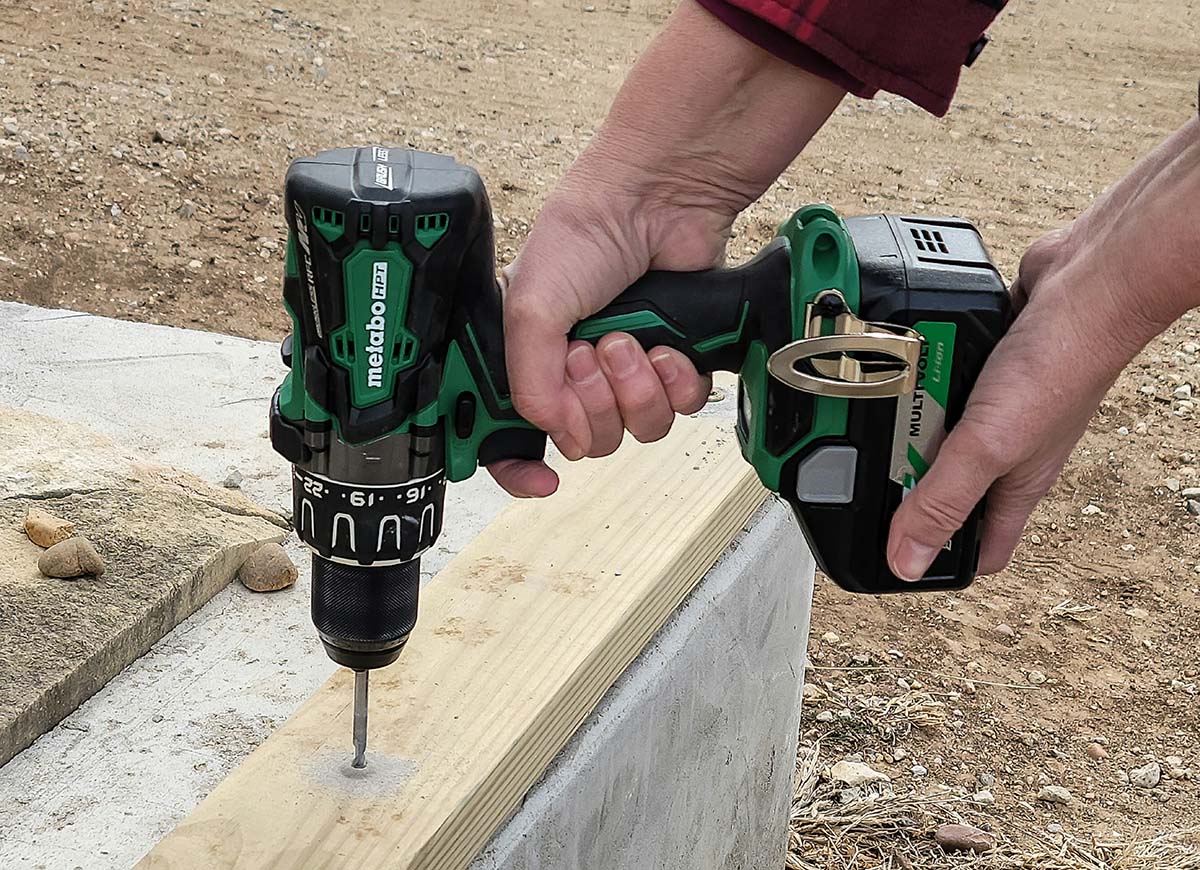
Drilling Materials
Hammer drills drill holes in masonry. A standard drill and drill bit will barely scratch the surface of porcelain tile, a concrete walkway, or a stone countertop. These materials are too dense for the cutting edge of a standard bit. A hammer drill fitted with a masonry bit will easily bore through these same surfaces. The hammer function helps drive the bit through the material as the bit spins. With that said, hammer drills are best suited for drilling holes in concrete, tile, stone, brick, and cinder block.
Keep in mind that masonry bits are necessary to get through these surfaces. These bits have wings on the tips to help remove dust from the hole, and their points are a slightly different shape—more chisel-like than a standard bit. Also, standard drill bits will dull or break almost immediately if they penetrate the surface of masonry material. Masonry bits can be found in kits or sold separately.
Motors
Two types of motors are available in power tools like cordless drills: brushed and brushless.
Brushed motors rely on the “old-school” technology for electric motors. These motors use a “brush” to send power to a coil. The coil, attached to a shaft, begins to spin, creating power and torque.
Brushless motors are far more efficient. They use sensors and control boards to send an electrical current to the coils, spinning a magnet attached to a shaft. This method produces significantly more torque and uses far less battery power than a brushed motor.
If drilling many holes, purchasing a brushless hammer drill might be worth the extra expense. Brushed hammer drills get the job done at a cheaper price tag but will probably take more time.
RPM, Torque, and BPM
When it comes to speed, consider a drill with a maximum rpm speed of 1,000 or more. Though that much speed is probably not necessary to drill through masonry materials, this speed allows the tool to be used as a drill driver when it’s not boring holes through concrete and brick.
Torque (twisting force) is also essential. To indicate torque, manufacturers may use “unit watts out” or UWO, which is a complex measurement of drill power at the chuck. A drill with at least 700 UWO should serve most purposes. Not all manufacturers list UWO, however.
Additionally, beats per minute, or bpm, should be a consideration. This measurement unit describes how often the hammer gear strikes the chuck per minute. A hammer drill with a bpm rating of 20,000 to 30,000 is suitable for most hammer-drilling scenarios, though heavier-duty models might offer lower bpm in exchange for increased torque. For example, drilling large-diameter holes may be easier with a hammer drill that features high torque power even if it comes with a lower bpm rating.
Clutch
Because hammer drills create so much torque, users need a way to regulate how much of that torque is available when using the drive feature on the tool to insert screws (if applicable). Too much torque can break a driver bit or strip out the head of the screw.
To control torque output, manufacturers may incorporate adjustable clutches in their hammer drills, but not all models have this option. Adjusting the clutch usually requires users to twist a collar at the base of the chuck to the correct position, though that position is always different from tool to tool and is dependent on the type of drilled material. For example, porcelain tile, which is very hard, might require a high clutch setting (as long as the fastener can handle it), while porous cinder brick will require less.
Chuck
There are two types of chucks to become familiar with: 3-jaw chucks and SDS chucks.
Most medium-duty hammer drills—use 3-jaw chucks. They clamp down on a round or hexagonal surface when the user twists the chuck. Three-jaw chucks allow users to use a wide range of drill bits and driver bits, which is why they’re nearly universal on drill drivers. They come in ½-inch and ⅜-inch sizes, with the larger size being more heavy duty.
Rotary hammers use SDS chucks that accept SDS bits. These bits have grooved shanks that lock into place. SDS is a German innovation, and the letters originally stood for the German words “steck, dreh, sitz,” which mean “insert, twist, stay.” Today, SDS is more commonly used to represent the English phrase “slotted drive system” or “slotted drive shaft.” These bits are different because rotary hammers provide massive force, which requires a more secure method of holding onto a bit.
Battery Type and Life
The main types of batteries that come with any cordless power tool are nickel-cadmium (NiCd for short) and lithium-ion. Lithium-ion batteries are replacing NiCd because they’re more efficient and last longer during use and in overall lifespan. They’re also considerably lighter. All the models that we tested came with lithium-ion batteries.
Battery life during use typically measures in Ah. For light-duty drill drivers, 2.0Ah batteries may be sufficient. When slamming a bit into masonry, however, users might want a battery to last longer. They will want to look for batteries with amp-hour ratings of 3.0Ah or more in these cases.
For those who need higher amp-hour ratings, batteries can often be purchased separately. Some manufacturers even sell batteries with as much as 12Ah.
Size and Weight
When shopping for the best cordless hammer drill for their particular needs, shoppers will want to consider project requirements. The size and weight of the hammer drill will depend on the project itself.
For example, drilling through porcelain wall tiles doesn’t require much torque, speed, or bpm. A light-duty, compact hammer drill weighing around 2 pounds without the battery can do the trick. On the other hand, drilling large holes for structural anchors in concrete will require a much larger, heavier hammer drill, possibly even a rotary hammer, which can weigh as much as 8 pounds without the battery.
A medium-duty hammer drill is an excellent choice for most DIY applications since it can tackle most projects. Although, keep in mind that it will be significantly heavier than a standard drill driver (often as much as twice the weight), so it might not be ideal as the only drill driver in a workshop.
FAQs
If you’ve never used a hammer drill before, you might have questions about the tools and how they work. You’ll find some of the most frequently asked questions and their answers below to help point you in the right direction.
Q. Can a hammer drill be used as a chisel?
If it has a chipping feature, you can use a rotary hammer drill as a chisel, such as our best overall pick in this lineup.
Q. Can I turn the hammer drill part off and use it as a regular drill?
Yes, many hammer drills function as drill drivers, though their high power might be overkill for most projects around the house.
Q. Why is my hammer drill not hammering?
Here are a few reasons your drill may not be hammering:
- You’re not putting enough pressure on the bit. The drill must feel some resistance from the bit to hammer it into the material.
- Your drill isn’t in hammer mode. There might be a dial on the side of the drill or a collar at the top of the machine that allows you to switch the drill into and out of hammer mode.
- Your hammer gear might have broken. Most likely, this is due to age or misuse, but it’s best to check into a new one if this is the case.
Why Trust Bob Vila
Bob Vila has been America’s Handyman since 1979. As the host of beloved and groundbreaking TV series including “This Old House” and “Bob Vila’s Home Again,” he popularized and became synonymous with “do-it-yourself” home improvement.
Over the course of his decades-long career, Bob Vila has helped millions of people build, renovate, repair, and live better each day—a tradition that continues today with expert yet accessible home advice. The Bob Vila team distills need-to-know information into project tutorials, maintenance guides, tool 101s, and more. These home and garden experts then thoroughly research, vet, and recommend products that support homeowners, renters, DIYers, and professionals in their to-do lists.
Meet the Tester
Glenda Taylor is a product tester and writer specializing in construction, remodeling, and real estate. She and her husband own a general contracting company, and she is experienced in both residential and commercial building applications. Taylor tests a wide range of power tools as well as other home improvement, household, and lawn-and-garden products.
Additional research provided by Tom Scalisi.
